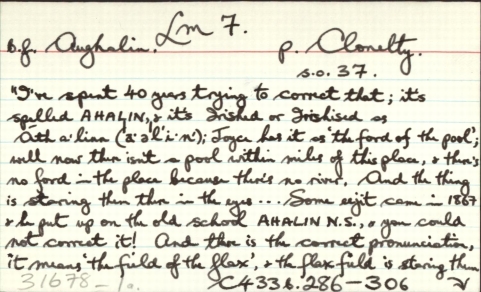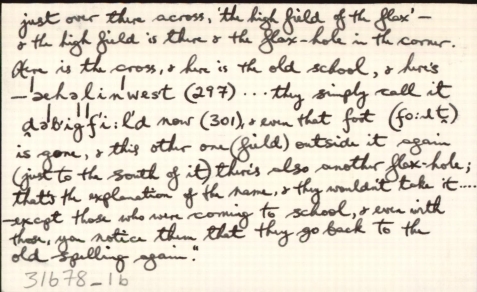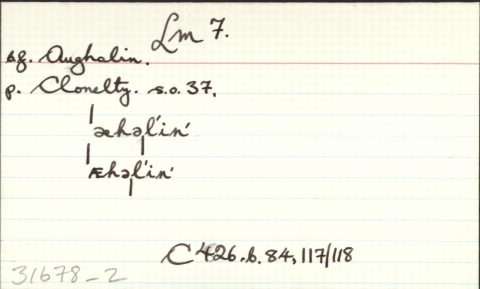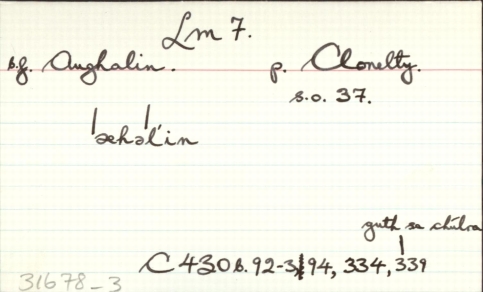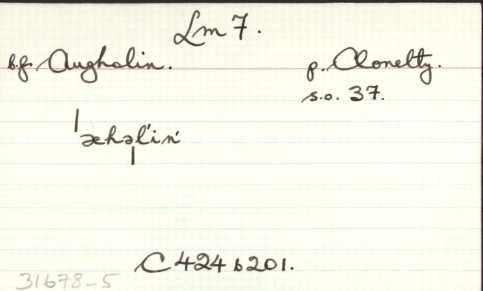Hierarchy
county
barony
civil parish
townland
subunits
Other names
Hierarchy
county
barony
civil parish
Explanatory note
- Gaeilge
Níl ceartfhoirm an bhunleagan Ghaeilge de Aughalin (nó Ahalin) cinnte. Tugann an fhianaise le fios gur áith “kiln” atá san aicmitheoir agus go mb’fhéidir gurb éard atá sa cháilitheoir ó cheart ná leagan gaelaithe den sloinne Lyn atá le fáil i measc na Sean-Ghall i Luimneach.
Tuairimítear go háitiúil gur Achadh Lín “(the) field of flax” an bunainm Gaeilge, ní nach ionadh agus an tionscal lín a bhí anseo tráth (féach an t-ábhar scanaithe). Ach ní réiteodh lín [g.] “of flax” leis na foirmeacha stairiúla ‘Athliny’, ‘Athlinye’ (bl. 1655–7), ‘Aheliny’, ‘Athlinny’ (1659), ‘Aghelinie’ (1750) ná ‘Aghalinny orse Aghalinagh’ (1807), ná ní thiocfadh sé leis an leagan áitiúil Gaeilge ‘áth a linne’ a breacadh in Ainmleabhar na Suirbhéireachta Ordanáis i 1840 (féach Logainmneacha na hÉireann, Imleabhar I: Contae Luimnigh, lch.2; eag. Art Ó Maolfabhail). Is léir ar an bhfianaise sin go raibh dhá shiolla sa cháilitheoir go stairiúil, rud a chuireann an focal aonsiollach Gaeilge lín as an áireamh. Níl an dara siolla seo den cháilitheoir le sonrú sa leagan oifigiúil béarlaithe Aughalin (1840 ar aghaidh) ach forbairt rialta is ea cailliúint ghuta neamhaiceanta deiridh sa bhéarlú (féach Townland Names of Co. Wexford/Ainmneacha na mBailte Fearainn, Co. Loch Garman, lgh.151–2, Balcarrig/Baile na Carraige; Conchubhar Ó Crualaoich & Aindí Mac Giolla Chomhghaill https://www.opw.ie/en/governmentpublications/specificitems-information/). Thairis sin, tabharfar faoi deara nach bhfuil guta fada an fhocail lín [g.] le sonrú sna tagairtí stairiúla ná san fhuaimniú áitiúil (1973c. /ˈæhəˌlʹinʹ/ Áit., et var.). Is léir ar an bhfianaise stairiúil, mar sin, nach dtagann Aughalin ó Achadh Lín.
Ach má chuireann na foirmeacha stairiúla lín as an áireamh, ní léir cad é an cáilitheoir a chuireann siad in iúl. Dá dheasca sin beartaíodh an réiteach fuaime liní a shocrú sa leagan oifigiúil Gaeilge .i. Áith Liní a daingníodh san Ordú Logainmneacha 2003.
Tá fianaise áirithe tagtha chun solais idir an dá linn a thabharfadh le fios go mb’fhéidir go mbaineann an cáilitheoir leis an sloinne Lyn atá ar taifead i measc na nAngla-Normannach i Luimneach (féach 1374 ‘William Lyn’ [Cnoc Áine], chancery.tcd.ie). Bheifí ag súil le An Lineach (gin. an Linigh) mar leagan gaelaithe den sloinne seo, rud a thabharfadh *Áith an Linigh “the kiln of the person called An Lineach (< Lyn)”, ainm Gaeilge a thiocfadh leis an bhfianaise stairiúil go léir.
Mar leis an aicmitheoir de, réitíonn áith (.i. foirnéis) leis na foirmeacha luatha ar nós ‘Athlyne’ (1586) agus ‘Athlini’ (1655–57). Is éadóigh linn gurb í an mhír choitianta áth “ford” atá anseo, cheal aon abhainn nó sruthán le dealramh a bheith le fáil sa bhaile fearainn. Díol mór spéise mar sin na tiníleacha a bhí suite in oirthear an bhaile fearainn tráth (féach 2x Lime Kiln (Disused) SO 25ʺ).
- English
The underlying Irish form of Aughalin (variant Ahalin) is not absolutely certain, although the overall evidence suggests that the initial element is from áith “kiln”, and the final element may be from a gaelicised form of the surname Lyn as attested among the Anglo-Normans in Limerick.
Derivation of Aughalin from Achadh Lín “(the) field of flax” has been suggested locally, which is attractive given the flax industry that once existed here (see scanned records). However, historical forms of the name such as ‘Athliny’, ‘Athlinye’ (dated 1655–7), ‘Aheliny’, ‘Athlinny’ (1659), ‘Aghelinie’ (1750) and ‘Aghalinny orse Aghalinagh’ (1807) as well as a local Irish version recorded in the Ordnance Survey Parish Name Book of 1840, namely ‘áth a linne’, are all incompatible with derivation of the final element from lín “of flax” ― lín has only one syllable in Irish, whereas Aughalin clearly had an extra syllable as reflected in the historical evidence of the name over a long period of time (see Logainmneacha na hÉireann, Imleabhar I: Contae Luimnigh, p.2; ed. Art Ó Maolfabhail). The absence of a final vowel from the later official anglicised form Aughalin is unproblematic and doubtless due to the common loss of unstressed final vowels in anglicisation (see Townland Names of Co. Wexford/Ainmneacha na mBailte Fearainn, Co. Loch Garman, pp.151–2, Balcarrig/Baile na Carraige; Conchubhar Ó Crualaoich & Aindí Mac Giolla Chomhghaill https://www.opw.ie/en/governmentpublications/specificitems-information/). It is also particularly noteworthy that neither the historical forms nor the local spoken form (1973c. /ˈæhəˌlʹinʹ/ Áit., et var.) reflect the long vowel present in lín “of flax”. Therefore *Achadh Lín cannot be the precursor to Aughalin in this instance―it is not reconcilable with the overall historical evidence for this place-name.
That said, while historical evidence absolutely rules out a final lín “of flax” in this place-name’s underlying Irish precursor, the identity of that final element remains somewhat unclear. It does reflect something similar to Liní, and for this reason the phonetic approximation Liní (meaning unclear) was adopted in the official Irish form of the name covered by a place-names order from 2003, namely Áith Liní.
However, in the meantime further evidence has come to light, particularly the occurrence of the surname Lyn (‘William Lyn’) among the Anglo-Normans in Limerick in 1374 at Knockainy (see chancery.tcd.ie) ― this surname or similar would have generated an Irish version such as An Lineach (gen. an Linigh) “the person called Lin < Lyn”, whence the possibility of an underlying Áith an Linigh “the kiln of the person called An Lineach (< Lyn)”, which is absolutely compatible with the historical evidence.
Initial Áith, a well-documented word meaning “kiln” is reflected in early historical forms of the name such as ‘Athlyne’ (1586) and ‘Athlini’ (1655–57) ― the more commonly-occurring áth “ford” is unlikely here given the absence of any river of size beside or in this townland. In this regard the presence of disused lime-kilns here is particularly notable (2x Lime Kiln (Disused) SO 25ʺ). (Both áith and áth would have the same pronunciation in Munster Irish.) [CÓC]
Centrepoint
Please note: Some of the documentation from the archives of the Placenames Branch is available here. It indicates the range of research contributions undertaken by the Branch on this placename over the years. It may not constitute a complete record, and evidence may not be sequenced on the basis of validity. It is on this basis that this material is made available to the public.
Archival and research material provided on this site may be used, subject to acknowledgement. Issues regarding republication or other permissions or copyright should be addressed to logainm@dcu.ie.
Permanent link
https://www.logainm.ie/31678.aspxFolklore
The National Folklore Collection (dúchas.ie) contains material related to this place:
Open data
Application programming interface (API)
Linked Logainm
Formats: RDF | RDF N3 | RDF JSON | RDF XML

